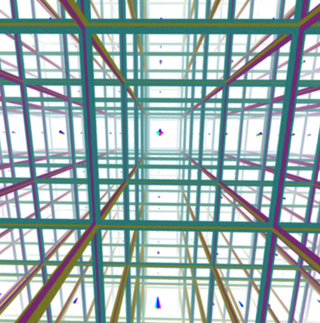In mathematics, specifically in homology theory and algebraic topology, cohomology is a general term for a sequence of abelian groups, usually one associated with a topological space, often defined from a cochain complex. Cohomology can be viewed as a method of assigning richer algebraic invariants to a space than homology. Some versions of cohomology arise by dualizing the construction of homology. In other words, cochains are functions on the group of chains in homology theory.
In mathematics, a closed manifold is a manifold without boundary that is compact. In comparison, an open manifold is a manifold without boundary that has only non-compact components.
In mathematics, specifically in homotopy theory, a classifying spaceBG of a topological group G is the quotient of a weakly contractible space EG by a proper free action of G. It has the property that any G principal bundle over a paracompact manifold is isomorphic to a pullback of the principal bundle . As explained later, this means that classifying spaces represent a set-valued functor on the homotopy category of topological spaces. The term classifying space can also be used for spaces that represent a set-valued functor on the category of topological spaces, such as Sierpiński space. This notion is generalized by the notion of classifying topos. However, the rest of this article discusses the more commonly used notion of classifying space up to homotopy.
In mathematics, real projective space, denoted or is the topological space of lines passing through the origin 0 in the real space It is a compact, smooth manifold of dimension n, and is a special case of a Grassmannian space.

In mathematics, a 3-manifold is a topological space that locally looks like a three-dimensional Euclidean space. A 3-manifold can be thought of as a possible shape of the universe. Just as a sphere looks like a plane to a small and close enough observer, all 3-manifolds look like our universe does to a small enough observer. This is made more precise in the definition below.
In mathematics, specifically algebraic topology, an Eilenberg–MacLane space is a topological space with a single nontrivial homotopy group.

In mathematics, systolic geometry is the study of systolic invariants of manifolds and polyhedra, as initially conceived by Charles Loewner and developed by Mikhail Gromov, Michael Freedman, Peter Sarnak, Mikhail Katz, Larry Guth, and others, in its arithmetical, ergodic, and topological manifestations. See also Introduction to systolic geometry.
In topology, Borel−Moore homology or homology with closed support is a homology theory for locally compact spaces, introduced by Armand Borel and John Moore in 1960.
In topology, a branch of mathematics, an aspherical space is a topological space with all homotopy groups equal to 0 when .
In Riemannian geometry, Gromov's optimal stable 2-systolic inequality is the inequality
In the mathematical field of Riemannian geometry, M. Gromov's systolic inequality bounds the length of the shortest non-contractible loop on a Riemannian manifold in terms of the volume of the manifold. Gromov's systolic inequality was proved in 1983; it can be viewed as a generalisation, albeit non-optimal, of Loewner's torus inequality and Pu's inequality for the real projective plane.
In Riemannian geometry, the filling radius of a Riemannian manifold X is a metric invariant of X. It was originally introduced in 1983 by Mikhail Gromov, who used it to prove his systolic inequality for essential manifolds, vastly generalizing Loewner's torus inequality and Pu's inequality for the real projective plane, and creating systolic geometry in its modern form.
In mathematics and specifically in topology, rational homotopy theory is a simplified version of homotopy theory for topological spaces, in which all torsion in the homotopy groups is ignored. It was founded by Dennis Sullivan and Daniel Quillen. This simplification of homotopy theory makes certain calculations much easier.

Systolic geometry is a branch of differential geometry, a field within mathematics, studying problems such as the relationship between the area inside a closed curve C, and the length or perimeter of C. Since the area A may be small while the length l is large, when C looks elongated, the relationship can only take the form of an inequality. What is more, such an inequality would be an upper bound for A: there is no interesting lower bound just in terms of the length.
In mathematics, particularly in homological algebra and algebraic topology, the Eilenberg–Ganea theorem states for every finitely generated group G with certain conditions on its cohomological dimension, one can construct an aspherical CW complex X of dimension n whose fundamental group is G. The theorem is named after Polish mathematician Samuel Eilenberg and Romanian mathematician Tudor Ganea. The theorem was first published in a short paper in 1957 in the Annals of Mathematics.
This is a glossary of properties and concepts in algebraic topology in mathematics.
In the mathematical subject of group theory, a co-Hopfian group is a group that is not isomorphic to any of its proper subgroups. The notion is dual to that of a Hopfian group, named after Heinz Hopf.
Chern's conjecture for affinely flat manifolds was proposed by Shiing-Shen Chern in 1955 in the field of affine geometry. As of 2018, it remains an unsolved mathematical problem.
A hyperbolization procedure is a procedure that turns a polyhedral complex into a non-positively curved space , retaining some of its topological features. Roughly speaking, the procedure consists in replacing every cell of with a copy of a certain non-positively curved manifold with boundary, which is fixed a priori and is called the hyperbolizing cell of the procedure.





